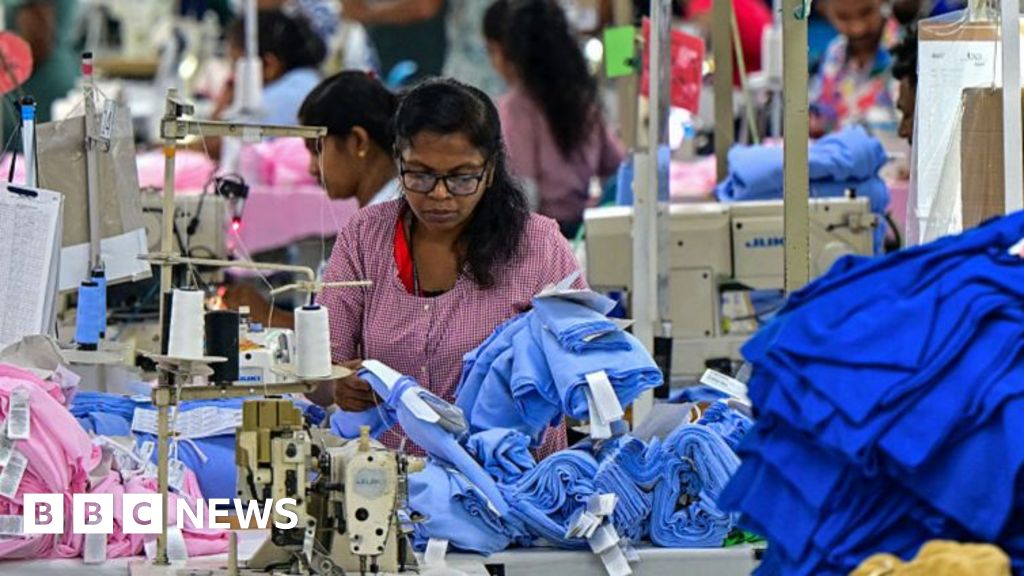【新闻摘要】
美国最近对亚洲服装出口国玩起了"关税俄罗斯轮盘赌":柬埔寨面临36%关税,斯里兰卡30%,而越南等国却获得更低税率。这让为耐克、Levi's代工的百万服装工人陷入恐慌——柬埔寨女工安索菲克每天祈祷"特朗普总统取消关税",因为她每月300美元的工资刚够喂饱两个孩子。最讽刺的是,这些国家当年正是被美国"配额制"扶持起来的,如今却要被同一双手推下悬崖。斯里兰卡服装协会哭诉:"越南关税比我们低,这仗怎么打?"而美国教授一语道破天机:"柬埔寨能买得起几架波音飞机?"更魔幻的是,这些国家现在还得在中美之间走钢丝——既要维持对华供应链,又要满足美国"去中国化"要求。看来这场"关税风暴"最惨的,还是那些每天踩10小时缝纫机、却可能连饭都吃不上的女工们。
---
**US tariffs threaten jobs of millions of Asian garment workers**
美国关税威胁数百万亚洲服装工人就业
**4 hours ago Share Save Kelly Ng BBC Singapore Amandika Cooray BBC Sinhala May Titthara BBC Khmer Share Save**
4小时前 分享 保存 BBC记者凯莉·黄 新加坡 阿曼迪卡·库里 科伦坡 梅蒂塔拉 金边 分享 保存
**Getty Images Apparel hubs like Cambodia and Sri Lanka face US tariff bombshell**
Getty Images 柬埔寨和斯里兰卡等服装出口国遭遇美国关税重击
Millions of garment workers across Asia are staring at an uncertain future as a US deadline to impose punishing tariffs looms. On 9 July, after a 90-day grace period for trade talks, the White House notified several Asian nations that new tariffs will take effect on 1 August. While lower than April's proposed rates, the revised levies have done little to calm nerves. Apparel powerhouses like Cambodia and Sri Lanka - which respectively face 36% and 30% tariffs - are particularly vulnerable, given their heavy reliance on the US market. American brands such as Nike, Levi's and Lululemon predominantly manufacture in these countries.
随着美国惩罚性关税最后期限临近,数百万亚洲服装工人面临不确定未来。7月9日,在90天贸易谈判宽限期结束后,白宫通知多个亚洲国家新关税将于8月1日生效。尽管税率低于4月提案,调整后的关税仍未能缓解焦虑。严重依赖美国市场的服装出口大国柬埔寨和斯里兰卡(分别面临36%和30%关税)尤其脆弱。耐克、Levi's和Lululemon等美国品牌主要在这些国家生产服装。
**"Can you imagine no food for children?"**
"能想象孩子挨饿的场景吗?"
Nao Soklin's hands tremble as she stitches another bag in her Cambodian factory. The 32-year-old mother of two works 10-hour days with her husband Kok Taok, earning a combined $570 monthly - barely enough for rent and their children's school fees."If we lose jobs, how will I feed my sons?" she asks, threading a needle under flickering lights. Her fears mirror those of 900,000 Cambodians and 350,000 Sri Lankans employed in apparel factories supplying US brands. Cambodia exported $3bn worth of garments to America last year, while Sri Lanka's $1.9bn apparel trade is its third-largest forex earner.
诺·索克林在柬埔寨工厂缝制手提包时双手颤抖。这位两个孩子的母亲与丈夫每天工作10小时,月收入合计570美元,勉强支付房租和孩子学费。"失业了怎么养孩子?"她在闪烁灯光下穿针引线时问道。她的恐惧反映了90万柬埔寨和35万斯里兰卡服装工人的处境——这些工厂为美国品牌代工。柬埔寨去年对美服装出口达30亿美元,斯里兰卡19亿美元的服装出口是其第三大外汇来源。
**Last-ditch tariff talks**
关税谈判最后冲刺
Sri Lankan negotiators are racing to secure further concessions after winning a 14-percentage-point reduction already."This is a promising start," says Finance Ministry Secretary Harshana Suriyapperuma. Cambodia, which secured a 13-point cut, continues lobbying."We're fighting for investors and workers," says Deputy PM Sun Chanthol, though he admits their"zero-tariff" goal looks unlikely. Both nations hope to avoid the fate of Myanmar, which faces the full 36% rate after failing to reach a deal.
斯里兰卡谈判代表在已争取到14%降税基础上寻求进一步让步。"这是个良好开端,"财政部秘书哈沙纳·苏里亚佩鲁马表示。柬埔寨获得13%降税后仍在游说。"我们为投资者和工人而战,"副总理孙占托表示,但他承认"零关税"目标难以实现。两国都希望避免缅甸的命运——未达成协议的缅甸将面临36%全额关税。
**Why is Trump turning the screws?**
特朗普为何收紧螺丝?
The US president insists the tariffs will rebalance trade, citing"unreciprocal" relationships. But Rutgers University's Prof Mark Anner calls this"economic amnesia" - America itself created these export hubs through preferential quotas. Until 2005, developing nations like Sri Lanka enjoyed guaranteed US market access."Now they're pulling the ladder up," Anner says. Delaware University's Prof Sheng Lu adds:"How many Boeings can Cambodia buy? Trade deficits with small economies are inevitable."
美国总统坚称关税将重新平衡贸易,指责"不对等"关系。但罗格斯大学教授马克·安纳称之为"经济健忘症"——美国当年通过优惠配额亲手培育了这些出口中心。2005年前,斯里兰卡等发展中国家享有美国市场准入保障。"现在他们抽掉了梯子,"安纳说。特拉华大学教授盛陆补充:"柬埔寨能买几架波音?与小经济体的贸易逆差不可避免。"
**The China factor**
中国因素
Complicating matters is the US-China rivalry. These garment nations now walk a tightrope - maintaining China-dependent supply chains while potentially needing to reduce Chinese inputs to please Washington."It's an impossible balancing act," says Prof Lu. Meanwhile, women like Cambodia's An Sopheak - who form 70% of garment workers - pray daily for tariff relief."My kids' hunger keeps me awake," says the single mother, earning $300 a month stitching Levi's jeans.
中美竞争使问题复杂化。这些服装出口国正走钢丝——既要维持依赖中国的供应链,又可能需减少中国原材料以取悦华盛顿。"这是不可能完成的平衡术,"盛陆教授说。与此同时,占服装工人70%的女性如柬埔寨的安索菲克每天祈祷关税取消。"孩子的饥饿让我失眠,"这位月薪300美元缝制Levi's牛仔裤的单亲母亲说。
**Getty Images Women workers face darkest hour**
Getty Images 女性工人面临至暗时刻
With Cambodia's poverty rate at 17.8% and Sri Lanka in economic crisis, the tariffs couldn't come at a worse time. Labor rights groups warn mass layoffs could trigger social unrest."This isn't just about exports - it's about survival," says Sri Lankan union leader Anton Marcus. As August looms, the whir of sewing machines across Asian factories carries a new note of dread.
柬埔寨贫困率达17.8%,斯里兰卡陷入经济危机,关税来得不是时候。劳工组织警告大规模裁员可能引发社会动荡。"这不只是出口问题,而是生存问题,"斯里兰卡工会领袖安东·马库斯表示。八月临近,亚洲工厂缝纫机的嗡鸣声中多了一丝恐惧。

